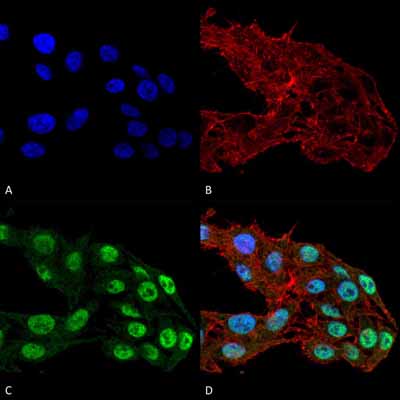DNMT1 Antibody
DNMT1 Antibody, Clone 11H8
- SPECIFICATION
- CITATIONS
- PROTOCOLS
- BACKGROUND

Application
| WB |
|---|---|
| Primary Accession | P26358 |
| Other Accession | NP_001370 |
| Host | Mouse |
| Isotype | IgG1 |
| Reactivity | Human, Mouse |
| Clonality | Monoclonal |
| Description | Mouse Anti-Human DNMT1 Monoclonal IgG1 |
| Target/Specificity | Detects ~180kDa. It will cross-react with mouse DNMT1. |
| Other Names | DNA Mtase Antibody, DNMT Antibody, MCMT Antibody, DNA methyltransferase 1 Antibody, AIM Antibody, CXXC9 Antibody, DNMT Antibody, DNA (cytosine-5)-methyltransferase 1 Antibody, CXXC-type zinc finger protein 9 Antibody, DNA methyltransferase HsaI Antibody |
| Clone Names | 11H8 |
| Immunogen | Raised against a synthetic peptide corresponding to amino acids 637-650 of human DNMT1 |
| Purification | Protein G Purified |
| Storage | -20ºC |
| Storage Buffer | PBS, 0.05% BSA, 0.05% sodium azide, 50% glycerol |
| Shipping Temperature | Blue Ice or 4ºC |
| Certificate of Analysis | 2 µg/ml of SMC-231 was sufficient for detection of Dnmt1 in 10 µg of mouse ES cell lysate by colorimetric immunoblot analysis using Goat anti-mouse IgG:HRP as the secondary antibody. |
| Cellular Localization | Nucleus |

Thousands of laboratories across the world have published research that depended on the performance of antibodies from Abcepta to advance their research. Check out links to articles that cite our products in major peer-reviewed journals, organized by research category.
info@abcepta.com, and receive a free "I Love Antibodies" mug.
Provided below are standard protocols that you may find useful for product applications.
Background
Methylation of DNA at cytosine residues plays an important role in regulation of gene expression, genomic imprinting and is essential for mammalian development. Hypermethylation of CpG islands in tumor suppressor genes or hypomethylation of bulk genomic DNA may be linked with development of cancer. To date, 3 families of mammalian DNA methyltransferase genes have been identified which include Dnmt1, Dnmt2 and Dnmt3. Dnmt1 is constitutively expressed in proliferating cells and inactivation of this gene causes global demethylation of genomic DNA and embryonic lethality. Dnmt2 is expressed at low levels in adult tissues and its inactivation does not affect DNA methylation or maintenance of methylation. The Dnmt3 family members, Dnmt3a and Dnmt3b, are strongly expressed in ES cells but their expression is down regulated in differentiating ES cells and is low in adult somatic tissue. Dnmt1 co-purifies with the retinoblastoma (Rb) tumour suppressor gene product, E2F1, and HDAC1. Dnmt1 also cooperates with Rb to repress transcription from promoters containing E2F-binding sites suggesting a link between DNA methylation, histone deacetylase and sequence-specific DNA binding activity, as well as a growth-regulatory pathway that is disrupted in nearly all cancer cells (1-6).
References
1. Bestor T., et al.(1988) J.Mol. Biol. 203: 971-983.
2. Yen R.W., Vertino P.M., Nelkin B.D., et al. (1992) Nucl. Acids Res. 20: 2287-2291.
3. Xie S., et al. (1999) Gene 236: 87-95.
4. Okano M., Bell D.W., Haber D.A. and Li E. (1999) Cell 99: 247-257.
5. Reik W. et al. (1999) J. Nat. Genet 23: 380-382.
6. Robertson K.D., et al. (2000) Nat Genet 25(3): 338-342.
If you have used an Abcepta product and would like to share how it has performed, please click on the "Submit Review" button and provide the requested information. Our staff will examine and post your review and contact you if needed.
If you have any additional inquiries please email technical services at tech@abcepta.com.













 Foundational characteristics of cancer include proliferation, angiogenesis, migration, evasion of apoptosis, and cellular immortality. Find key markers for these cellular processes and antibodies to detect them.
Foundational characteristics of cancer include proliferation, angiogenesis, migration, evasion of apoptosis, and cellular immortality. Find key markers for these cellular processes and antibodies to detect them. The SUMOplot™ Analysis Program predicts and scores sumoylation sites in your protein. SUMOylation is a post-translational modification involved in various cellular processes, such as nuclear-cytosolic transport, transcriptional regulation, apoptosis, protein stability, response to stress, and progression through the cell cycle.
The SUMOplot™ Analysis Program predicts and scores sumoylation sites in your protein. SUMOylation is a post-translational modification involved in various cellular processes, such as nuclear-cytosolic transport, transcriptional regulation, apoptosis, protein stability, response to stress, and progression through the cell cycle. The Autophagy Receptor Motif Plotter predicts and scores autophagy receptor binding sites in your protein. Identifying proteins connected to this pathway is critical to understanding the role of autophagy in physiological as well as pathological processes such as development, differentiation, neurodegenerative diseases, stress, infection, and cancer.
The Autophagy Receptor Motif Plotter predicts and scores autophagy receptor binding sites in your protein. Identifying proteins connected to this pathway is critical to understanding the role of autophagy in physiological as well as pathological processes such as development, differentiation, neurodegenerative diseases, stress, infection, and cancer.


